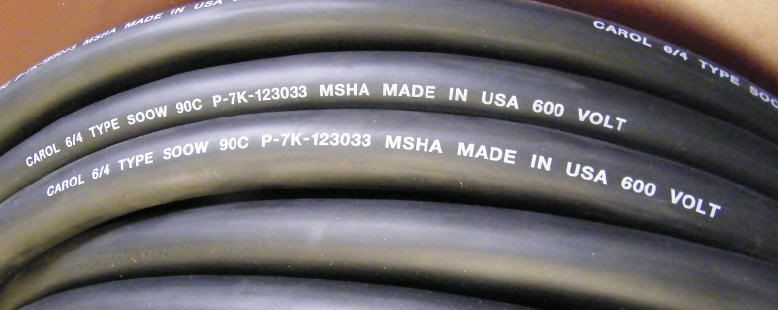ERP
Member
- Location
- California
Hi:
I have been coming to Mike Holt?s website and occasionally lurking here when I have an electrical question and have always readily been able to find my answers, but now I am into some stuff where Google and lurking are not going to answer my questions!
We have just begun running a 480v 3 phase generator on a trailer, then main power cables to a distribution box, which then is distributed to power multiple 460v heaters at industrial jobsites.
As using this type of equipment and working with this kind of voltage is new for our firm, I have a host of questions.
First Question: The main power cords are either 50 or 75 foot lengths of Carol 6/4 600VAC with Hubbell 50amp ends. (Photos below) The challenge is we are frequently running these a lot further than 75 feet, so the manufacturer tells us to daisy chain these together! I have always understood daisy-chaining was a no-no, but they say this is fine up to 800 feet with these cords (daisy-chaining up to 16 cords!) From a pure safety standpoint my biggest concern is with these cords being disconnected or re-connected with a 480V load on them. So is this legal and safe or not?
Second Question: I am being further told we are to run these up the sides of buildings daisy-chained. Even with some safety straps I cannot see how this can be safe or legal!
I have more questions, but I figure I will leave it at these two for this first post!
Thanks!
Eric




I have been coming to Mike Holt?s website and occasionally lurking here when I have an electrical question and have always readily been able to find my answers, but now I am into some stuff where Google and lurking are not going to answer my questions!
We have just begun running a 480v 3 phase generator on a trailer, then main power cables to a distribution box, which then is distributed to power multiple 460v heaters at industrial jobsites.
As using this type of equipment and working with this kind of voltage is new for our firm, I have a host of questions.
First Question: The main power cords are either 50 or 75 foot lengths of Carol 6/4 600VAC with Hubbell 50amp ends. (Photos below) The challenge is we are frequently running these a lot further than 75 feet, so the manufacturer tells us to daisy chain these together! I have always understood daisy-chaining was a no-no, but they say this is fine up to 800 feet with these cords (daisy-chaining up to 16 cords!) From a pure safety standpoint my biggest concern is with these cords being disconnected or re-connected with a 480V load on them. So is this legal and safe or not?
Second Question: I am being further told we are to run these up the sides of buildings daisy-chained. Even with some safety straps I cannot see how this can be safe or legal!
I have more questions, but I figure I will leave it at these two for this first post!
Thanks!
Eric




